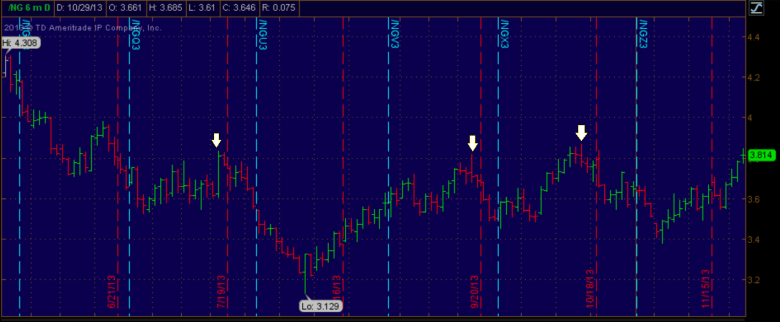Much like how oil lubricates the engine of your car, oil is the single most important input for lubricating the global economic engine. As such, a host of fundamental factors can influence its price, making crude oil arguably one of the most complex commodities to trade. Even ex-traders from the supposed masters of the universe, Goldman Sachs, were torched trading the spread between Brent and West Texas Intermediate in October. Thinking it would shrink, it rose as oil shale production in the U.S. defied expectations and headlines in the Middle East pushed up Brent prices among many other factors I have no clue about.
Further pressuring WTI crude prices, last month the U.S. surpassed Saudi Arabia as the world’s largest producer of hydrocarbon products. Saudi Arabia and Russia still produce 3 million barrels more crude than the United States; but in the long-term, the U.S. will pass both in crude production after 2020 continuing until around 2030. That is if you believe the current projections for the amount of recoverable oil still in the ground.
Presently, at least, oil is overflowing in Cushing, Oklahoma, the WTI futures contract deliver point, as the United States Energy Information Administration noted that crude stockpiles have risen for nine straight weeks.
Perfectly illustrating American’s oil production renaissance is this nighttime satellite image of Earth taken last year, below, highlighting the immense size and scale of the North Dakota shale boom. In most cases, the bright orbs represent dense population centers where lights are the brightest, such as Denver or Los Angeles. Not so in the northwestern corner of North Dakota. That bright (circled) spot represents the drilling operations at the Bakken Formation composed mostly of natural gas burn-off.

North Dakota Shale Oil & Gas Wells Light Up the Night Sky
High Prices Cure Themselves
In the previous decade, oil was a one-way bet as prices rose from 2002 to 2008, rising from $20 a barrel to more than $147. But as is often the case, the best cure for high prices is… high prices. The oil industry introduced new techniques to tap into oil that was previously cost prohibitive to drill and now no one is quite sure how much unconventional oil can be produced and for how long.
Looking at the big picture, crude oil, at least the WTI variety, is bearish and prices are reflecting this sentiment. After peaking at $112 on August 28, WTI crude has shaved off nearly $18 in the front month contract. The unrelenting flow of supply has overshadowed all other factors, including an improving economy, changes to the ethanol mandate and on-going turmoil in the Middle East, as demonstrated by the orderly downtrend in the three-month daily chart, below.

Crude Oil Prices in the U.S. are sinking under record supply
WTI Crude to the $80s?
In the past two weeks NYMEX oil has consolidated between $93 and $96 per barrel. Following the old adage that prices follow the path of least resistance, once can reasonably assume a continuation of a drown trend. If that happens, prices must pass through long-term support at $92 and $90 before breaking into the $80s. Barring any sort of supply shock or an airstrike on Iran, WTI prices will remain under pressure for the time being.




